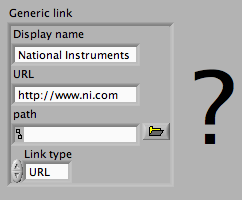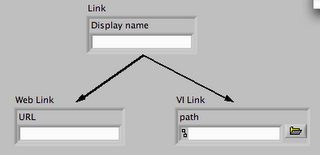The Class: a Cluster of Clusters
Imagine you have some buttons that open web pages when you click on them. You have, for each button, a cluster of the display name and the URL to open when the button is clicked. Now you want to have some buttons run VIs when the user clicks on them, so you make another cluster with the display name and the path of the VI to run.
Well, this isn't really satisfactory, is it? Display name is duplicated in both clusters. And you can't make an array that includes both kinds of links.

Another approach might be to make a unified cluster, with the display name, URL and path. But now you need a way to know whether the URL or the path is valid in a given cluster, so you'd have to add some kind of selector. And, as you add new kinds of links, this cluster is going to grow and grow.

What you really want is to put the common fields in one cluster, and the fields for each specific kind of link in other clusters. This is where classes can help.
So... when I said you can think of a class as a cluster, I kind of lied. Really, you can think of it as a cluster of clusters. If Link is the parent class, and Web link is its child class, then the data for a Web link object includes both the Link private data cluster and the Web link private data cluster.
This is called inheritance. It lets you break out the data and behavior into a logical hierarchy. There's lots more to say about this, but I'll leave that for future posts.

Well, this isn't really satisfactory, is it? Display name is duplicated in both clusters. And you can't make an array that includes both kinds of links.

Another approach might be to make a unified cluster, with the display name, URL and path. But now you need a way to know whether the URL or the path is valid in a given cluster, so you'd have to add some kind of selector. And, as you add new kinds of links, this cluster is going to grow and grow.

What you really want is to put the common fields in one cluster, and the fields for each specific kind of link in other clusters. This is where classes can help.
So... when I said you can think of a class as a cluster, I kind of lied. Really, you can think of it as a cluster of clusters. If Link is the parent class, and Web link is its child class, then the data for a Web link object includes both the Link private data cluster and the Web link private data cluster.
This is called inheritance. It lets you break out the data and behavior into a logical hierarchy. There's lots more to say about this, but I'll leave that for future posts.

Labels: labvoop

0 Comments:
Post a Comment
<< Home